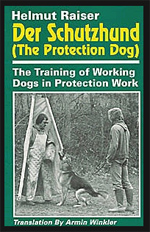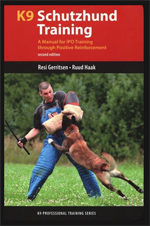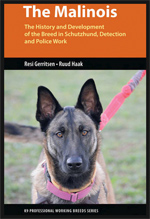Schutzhund
Table of Contents
- Brief Description of Schutzhund Training
- Schutzhund Clubs & Training Centres (National / International / Regional)
- Additional Resources/References
- Books & DVDs
A Brief Description of Schutzhund Training
Schutzhund is a German word meaning “protection dog.”
Schutzhund is the historical means by which genetic breed temperament has been tested and maintained, and is not simply a sport. The concept of these working tests started in Europe at the beginning of the 20th Century when early developers of the German Shepherd Dog, among them Captain Max von Stephanitz, realized that, with modernization of rural life, the working dogs could soon become unnecessary. Recognizing that the German Shepherd was extremely versatile and capable of adapting to all types of functions, a system of standards was adapted in order to identify those dogs considered to be suitable as breeding stock. While conformation shows established correct type and physical structure, these working tests identified the dogs who had the necessary drive, character and overall working ability. It is from these working tests that the sport of Schutzhund evolved.
Schutzhund training concentrates on three areas: Tracking, Obedience, and Protection work. Schutzhund measures the dog’s mental stability, endurance, structural efficiencies, ability to scent, willingness to work, courage and trainability. One of the most important qualities of a Schutzhund trained dog is his complete obedience under distraction.
Tracking — The Tracking phase is intended to test the dog’s trainability, scenting ability and its mental and physical endurance. In this test, the dog is required to track footsteps and find objects over mixed terrain, change direction and show absolute accuracy and commitment to the task. The tests vary in length, shape, and difficulty depending on the title sought.
Obedience — The Obedience exercises test the dog’s temperament, structural efficiencies and its willingness to serve. The obedience phase includes several exercises: including heeling on and off leash; heeling through distractions including groups of people and/or the firing of a gun; sit, down, stand, stay, recall; retrieving over a one meter jump and a six foot wall.
Protection — The Protection phase of Schutzhund training involves testing the dog’s courage, physical strength and agility. During this phase, the relationship between dog and handler is of utmost importance. Exercises include, among others, a search of hiding places, finding a hidden human decoy, and guarding that decoy while the handler approaches. The dog is then expected to pursue the decoy when an escape is attempted. The dog must never bite unless either the dog or the handler is attacked, in which case, the dog must attack fully and without hesitation. However, all bites are expected to be placed on the padded sleeve worn by the decoy and the dog MUST release on command of the handler and guard the decoy without any further aggression. In Schutzhund protection work, the dog must at all times be under the absolute control of the handler.
While the sport is open to all breeds, including mixed-breeds, it is traditionally a Working and Herding dog sport. German Shepherd Dogs, Doberman Pinschers, Rottweilers, Belgian Malinois, Airedale Terriers, Boxers, Bouvier des Flandres, and Giant Schnauzers are the most common breeds involved in the sport, with the German Shepherd Dog being the most common.
Dog and Handler teams compete for titles at three levels — SchH1, SchH2, and SchH3 — with each being increasingly more difficult to earn. In addition, there are other titles including Advanced Tracking (FH1 and FH2), Endurance Certificates (AD), Police Dog training and Agility work.
A dog trained in Schutzhund is generally an excellent companion in the home as well as a good candidate for police work and search and rescue. The Schutzhund trained dog has confidence and trust in himself. He is approachable, quietly standing his ground, calm but eager and alert when the situation warrants.

Arden vom Canisphere SchH1
Photo credit: Canisphere German Shepherds
Clubs and Additional Information:
National/International Clubs:
- German Shepherd Schutzhund Club of Canada — The GSSCC is a corporation of clubs from every part of Canada. The goals are directed toward the promotion of the German Shepherd Dog.
- United Schutzhund Club of America for the German Shepherd Dog (USA)
- Deutscher Hundesportverband (DHV) — The German Working Dog Association
- American Working Dog Federation (AWDF) — Founded in 1989 to strengthen the working breeds in the United States. All member clubs of the AWDF share the goal of preserving and protecting the working dogs’ heritage in America.
- American Working Malinois Association (AWMA) — The AWMA is a working dog club developed to promote and preserve the working Malinois as intended by its native country of origin, Belgium. The AWMA is a member of the Fédération Mondio Berger Belge (FMBB), the World Union for the Working Belgian Shepherd Dog, as well as a full member of the AWDF.
- North American Working Bouvier Association (NAWBA) — NAWBA encourages training and use of the Bouvier for work consistent with the heritage and original function of the breed, including, but not limited to, protection work, obedience, tracking, and herding.
- United Doberman Club (UDC) — The UDC was formed in 1990 with members from around the world who are dedicated to preserving and protecting the Doberman and its heritge as a Working Dog. The UDC is a member club of the AWDF and the International Doberman Club (IDC).
- United States Boxer Association (USA-BOX) — An organization that is dedicated to preserving, protecting and promoting the working dog heritage of the Boxer breed. The USA-BOX is the official United States representative Boxer club for the Association Technique Internationale du Boxer (ATIBOX), the world Boxer organization. The USA-BOX is also a member of the AWDF.
- United States Rottweiler Club (USRC) — The USRC is an International Organization whose membership is dedicated to the complete Rottweiler in character, conformation and working ability. USRC is a member of the AWDF. The USRC conducts its own Schutzhund Trials and has its own Scorebooks and paperwork. USRC scores are recognized by the ADRK and all AWDF member clubs including the United Schutzhund Clubs of America.
- Federation for the American Staffordshire Terrier (FAST) — A member club of the AWDF, FAST is dedicated to preserving and protecting working heritage of the American Staffordshire Terrier.
- Working Riesenschnauzer Federation (WRSF) — The WRSF was established in 1991 and formed to help ensure the preservation and betterment of the Giant Schnauzer (Riesenschnauzer) in the United States and throughout the world. The WRSF is a member of the AWDF and the International Schnauzer-Pinscher Union (ISPU).
- Working Pitbull Terrier Club of America (WPBTCA) — Dedicated to the American Pit Bull Terrier and opening the eyes of the world to the true working abilities and qualities of this breed. The WPBTCA is an AWDF recognized club, established in 2003. The WPTCA focuses on events such as Schutzhund, Ring Events, Agility, Obedience, Weight Pulls, and Conformation.
- North American Working Airedale Terrier Association (NAWATA) — An organization that is dedicated to preserving, protecting and promoting the working dog heritage of the Airedale Terrier breed.
- Verein für Deutsche Schäferhunde (SV) — World Union of German Shepherd Dog Clubs (WUSV)
Regional Clubs:
British Columbia:
- The West Coast German Shepherd Schutzhund Club (WCGSSC) — Dedicated to the pursuit of excellence in training and competing in the sport of Schutzhund. (Surrey, British Columbia)
- Victoria Rottweiler Club— An all-breed Schutzhund dog sport club, located in Victoria, British Columbia.
- Southern Vancouver Island Schutzhund Club (SVISC) — An active member of the German Shepherd Schutzhund Club of Canada (GSSCC), the governing association for Schutzhund sport in Canada. The SVISC also recognizes other clubs in the association and affiliations with the Verin fur Deutsche Schaferhund (SV) and the VDH.
Prairies:
- Alberta Schutzhund Association
- The Winnipeg Working Dog Club — In existence since 1995, training, primarily German Shepherd Dogs, in schutzhund – from all levels, beginner to World championship.
Ontario:
- Capital City Schutzhund Club — Markham, Ontario
- Saugeen Schutzhund Club — An all breed training club in the sport of Schutzhund, located in Orangeville, Ontario
- York Region Schutzhund Club — An all breed training club in the sport of schutzhund.
Quebec:
- Club Schutzhund Pro-Sport — Quebec
Maritimes:
- Newfoundland Schutzhund Club — A small group working together as a dog club in the sport of Schutzhund.
Resources/References:

Der Schutzhund – The Protection Dog
The Training of Working Dogs in Protection Work. Gives equal consideration to the duties of handler, dog, and helper. Part 1: discusses prey, defense, aggression, and fighting drives which are used in the training protection work; also explains basic ethological terms and laws, such as instinctive action, trigger stimulus, drive goal, conflict behavior, etc. Shows classical and instrumental conditioning as the typical methods through which dogs learn. Part 2: methodical instruction on how to develop and train dogs in protection work.
CLICK HERE to learn more and to purchase.

K9 Schutzhund Training: A Manual for IPO Training Through Positive Reinforcement 2nd Edition
This new edition provides a hands-on, practical approach to training your K9 for IPO levels 1, 2 and 3. Beginners will receive an excellent introduction to the sport of Schutzhund, while expert trainer will stay on top of their game with the latest techniques. Using proven methods rooted in classical and operant conditioning, Dr. Resi Gerritsen and Ruud Haak, world-renowned specialists in training working dogs, have developed this practical and positive Schutzhund training program.
CLICK HERE to learn more and to purchase.

The Malinois: The History and Development of the Breed in Schutzhund, Detection and Police Work
The Malinois is one of the most effective working dog breeds in the world, prized for their intelligence and high energy level. This breed, which for centuries served as the ultimate sheepdog, has become increasingly popular among police departments and militaries that recognize its unique suitability for detection and police work.
CLICK HERE to learn more and to purchase.
Quick Links
Get In Touch
- Email: canadasguidetodogs@gmail.com
- Email: info@canadasguidetodogs.com
- Visit us on Facebook: www.facebook.com/CanadasGuideToDogs
— CanadasGuideToDogs.com is an Amazon Associate as well as a participant in various affiliate programs, as such fees are earned from qualifying purchases.

